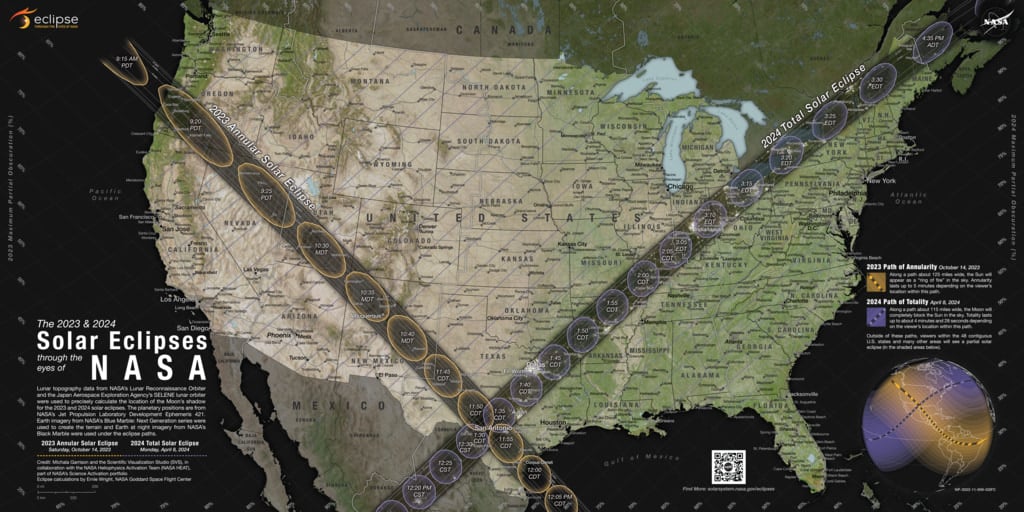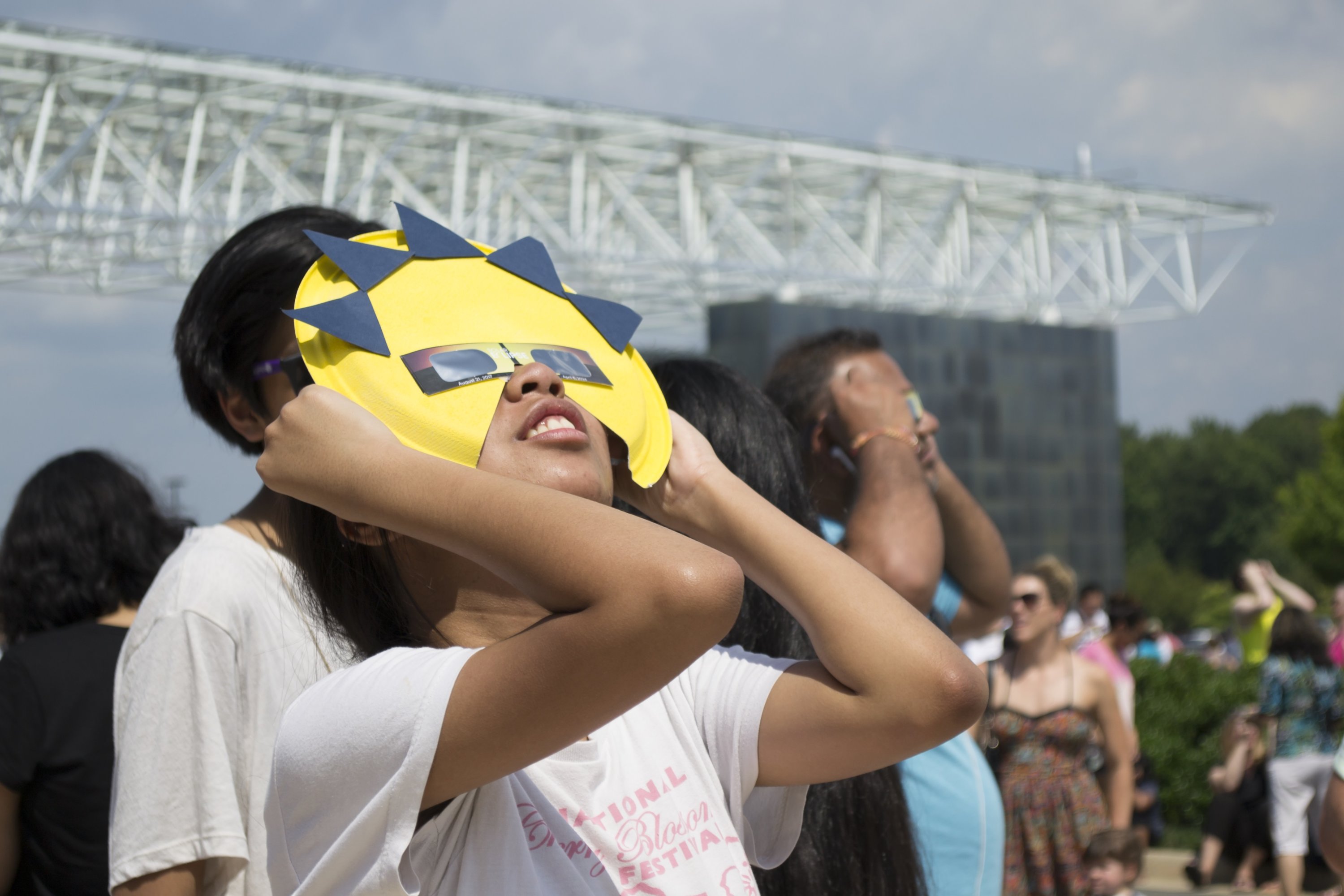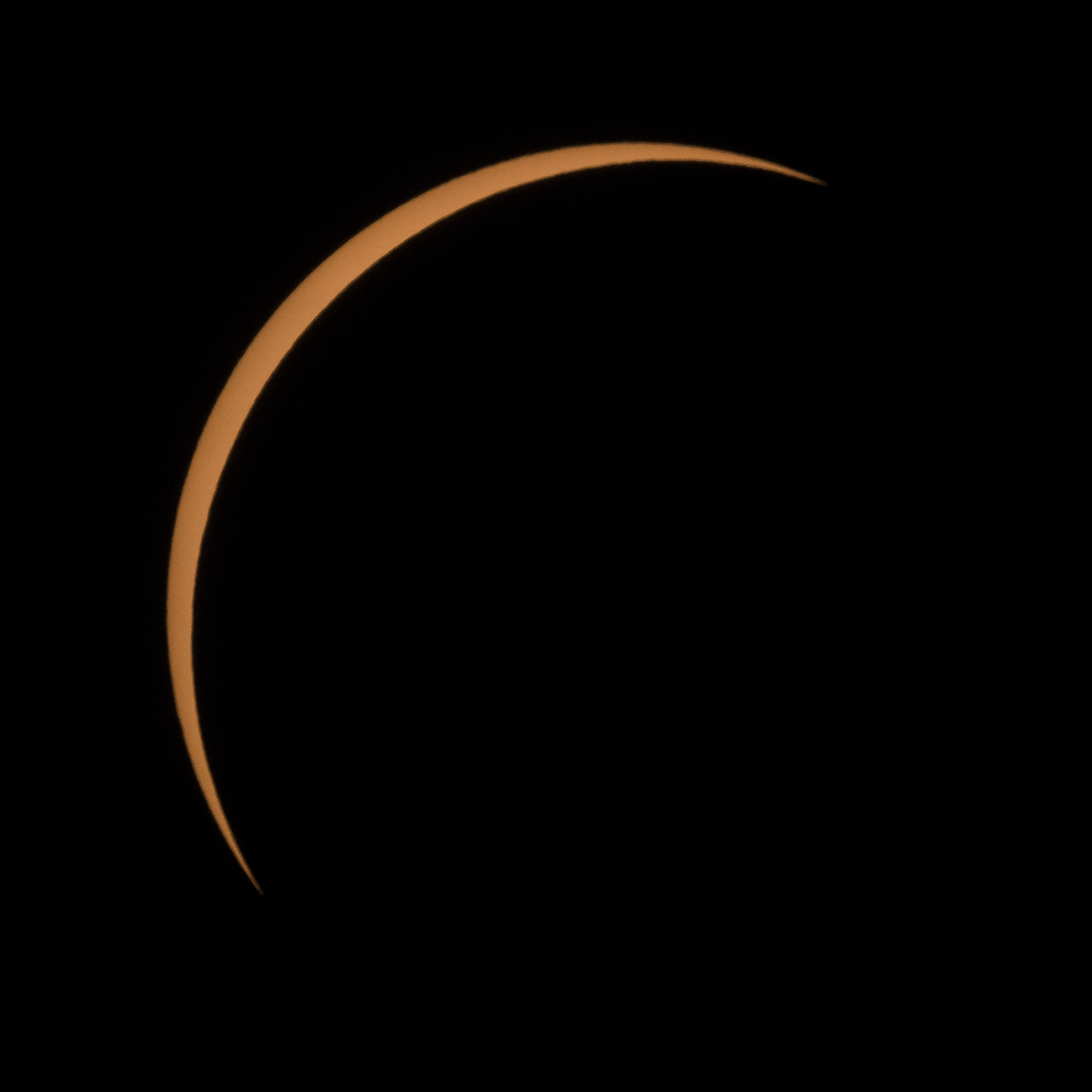The moon is seen passing in front of the sun during the 2017 solar eclipse. Photo: (NASA/Joel Kowsky)
A total solar eclipse will take place on Monday, April 8. Here’s everything you need to know about the solar event.
What’s the deal with this eclipse?
On Monday, April 8, a total solar eclipse will pass across North America, meaning the moon will completely cover the sun for a period of time, turning day into night for a few minutes. The last time a total eclipse occurred in North America was in August 2017, and the next such event will occur in August 2044.
“What makes it so unique is that the path of totality will pass through the largest portion of the American public ever,” said Kelly Korek, NASA’s program manager for the 2024 eclipse. “So 31.5 million people are in the path of totality, and the contiguous 48 states, as well as parts of Alaska and Hawaii, will actually experience a partial eclipse as well.”
Can I see the total eclipse everywhere?
Sorry, but only places in the path of totality will be able to fully experience the darkness of daylight. What viewers in these locations will see is the full shift of the moon over the sun, plunging us into a false night, except for bits of the sun’s corona (the star’s outer atmosphere).
“Another special part of this eclipse is that the sun is at maximum activity,” says Korek. “If people have seen previous eclipses or pictures of previous eclipses, sometimes you see pink threads or fingers or tentacles coming out that look like them. These things are threads or casting of these active areas. You should see more of that, more crown wisdom structure during this solar maximum time.”
Is DC in the path of totality?
Here’s the bad news: Washington is not on the path of totality, reaching only 87.3% lunar coverage. Still, that’s more than last year’s “ring of fire” eclipse, where the sun reached 29.7% obscuration.
“It will be more of a cloudy day. The sun will be a little weaker – you will need to wear glasses if you look at the sun. You don’t have to do it on a daily basis,” Korek says. “The light will get a little longer and the shadows a little sharper.”

Where should I travel to see the total eclipse?
The closest places to D.C. to see the total eclipse are Erie, Pennsylvania, and Cleveland, Ohio, both about a six-hour drive away. Totality in Cleveland will last three minutes and 49 seconds, starting at 3:13 p.m. In Erie, it will reach its full value at 3:16 p.m., lasting three minutes and 42 seconds. Lodging is booking up fast (and prices are inflated because of it), but you can still find hotels and campgrounds in Erie, as well as accommodations in Cleveland.
Where can I watch the partial eclipse in situ?
While you won’t be able to see the total reach of the eclipse around DC, there are a few ways to celebrate the (partial) celestial event close to home.
Naturally, the National Museum of Aviation and Cosmonautics has several events planned. There’s a skyfest on the National Mall from 12pm to 4pm with telescopes and educational activities, as well as a chance to peer into the phenomenon through telescopes at the Udvar-Hazy Center (14390 Air and Space Museum Pkwy., Chantilly) from 14:00 to 16:00.
The Turner Farm Observatory (925 Springvale Rd., Great Falls) is holding an eclipse viewing event starting at 1:30 p.m., where people can learn more about the science behind the solar phenomena. Tickets are $10 and include a pair of eclipse glasses. A group viewing session with telescopes is also held at Gateway Park (1300 Langston Blvd., Arlington) from 14:00 to 16:00, as well as another in Observatory Park (100 Desellum Ave., Gaithersburg) from 14:00 to 16:30. Both events offer sunglasses while supplies last.
For a free eclipse celebration, head to Deck 11, the rooftop bar at the Capitol Hill Yotel Washington DC (415 New Jersey Ave., NW)for drinks, snacks and eclipse glasses from 2 to 5 p.m.

Where can I find eclipse glasses?
Starting at the end of the month, the Air and Space Museum and the Udvar-Hazy Center will be giving away eclipse glasses. You can also order a pair online from a company vetted by the American Astronomical Society. Both NASA and AAS emphasize that viewing glasses must meet the international safety standard ISO 12312-2.
How else can I get involved on the day of the eclipse?
NASA is holding a series of grassroots “citizen science” programs to commemorate the event. The Eclipse Soundscapes Project encourages people to record audio before, during and after the eclipse. Korek points to the animal kingdom as an example of how sound can capture the strangeness of a solar event. “If you’re around roosters, the roosters will go to bed and then crow when the sun comes back,” Korek says. “Things really think it’s night and then another dawn because the sun is coming back.” Another project, SunSketcher, requires eclipse watchers to share pictures of the moon above the sun on an app so researchers can build a database image data to analyze.
What if I want to start celebrating early?
If you’re into the moon stuff, you don’t have to wait until April 8 to get busy. On March 20, Club DC9 (1940 9th St., NW) will host speakers to discuss the upcoming eclipse, plus trivia and free eclipse glasses. The DC Public Library will hold film screenings through April 1 at the Martin Luther King Jr. Memorial Library (901 G St., NW) to celebrate the eclipse by showing space-themed films such as the martian and Arrival.
Air and Space Museum curator Samantha Thompson will talk about the eclipse experience during a talk at the Shaw Neighborhood Library (1630 7th St., NW) on March 26, highlighting some of the logistical details, such as how to safely look at the sun. Get a timed admission pass at the Air and Space Museum on April 6 to participate in a kid-friendly eclipse prep day with an educational program.
“It’s not something you necessarily have to have a Ph.D. in to understand and appreciate. It just creates some curiosity,” Korek says. “People are curious creatures, so let’s be curious about it.”

